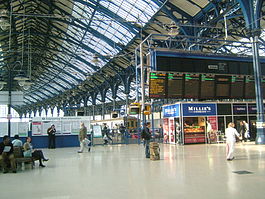Brighton station
| Brighton |
|
|---|---|

Station concourse
|
|
| Location | |
| Place | Brighton |
| Local authority | City of Brighton and Hove |
| Coordinates | 50°49′44″N 0°08′28″W / 50.8288°N 0.1411°WCoordinates: 50°49′44″N 0°08′28″W / 50.8288°N 0.1411°W |
| Grid reference | TQ310049 |
| Operations | |
| Station code | BTN |
| Managed by | Southern |
| Owned by | Network Rail |
| Number of platforms | 8 |
| DfT category | B |
| Live arrivals/departures, station information and onward connections from National Rail Enquiries |
|
| Annual rail passenger usage* | |
| 2011/12 |
|
| – Interchange |
|
| 2012/13 |
|
| – Interchange |
|
| 2013/14 |
|
| – Interchange |
|
| 2014/15 |
|
| – Interchange |
|
| 2015/16 |
|
| – Interchange |
|
| History | |
| Key dates | Opened 11 May 1840 |
| Listed status | |
| Listed feature | Brighton station including train sheds |
| Listing grade | Grade II* listed (since 26 August 1999) |
| Entry number | 1380797 |
| Added to list | 30 April 1973 |
| National Rail – UK railway stations | |
| * Annual estimated passenger usage based on sales of tickets in stated financial year(s) which end or originate at Brighton from Office of Rail and Road statistics. Methodology may vary year on year. | |
|
|
|
Brighton railway station is the southern terminus of the Brighton Main Line in England, and the principal station serving the city of Brighton and Hove, East Sussex. It is 50 miles 49 chains (81.45 km) down-line from London Victoria; the preceding station is Preston Park.
The station is managed by Southern, which also operates many of the trains. Thameslink, Gatwick Express and Great Western Railway also operate some trains from Brighton.
It was built by the London & Brighton Railway in 1840, initially connecting Brighton to Shoreham-by-Sea, westwards along the coast, and shortly afterwards connecting it to London Bridge and the county town of Lewes to the east. In 1846, the railway became the London Brighton and South Coast Railway following mergers with other railways with lines between Portsmouth and Hastings.
With almost 16.1 million passenger entries and exits in 2011/12, Brighton was then the seventh-busiest station in the country outside of London.
The London and Brighton Railway (L&BR) built a passenger station, goods station, locomotive depot and railway works on a difficult site on the northern edge of Brighton. This site was 0.5 miles (0.80 km) from, and 70 feet (21 m) above the sea shore, and had involved considerable excavation work to create a reasonable gradient from Patcham Tunnel.
The passenger station was a three-storey building in an Italianate style, designed by David Mocatta in 1839–40 which incorporated the head office of the railway company. (This building still stands but has been largely obscured by later additions.) The station is said to have many similarities to the Nine Elms railway station of the London and Southampton Railway (1838) designed by Sir William Tite. Baker & Son were paid £9766 15s for the station building between May and August 1841. The platform accommodation was built by John Urpeth Rastrick and consisted of four pitched roofs each 250 ft long (76 m). It opened for trains to Shoreham on 11 May 1840, and in September 1841 for trains to London.
...
Wikipedia
